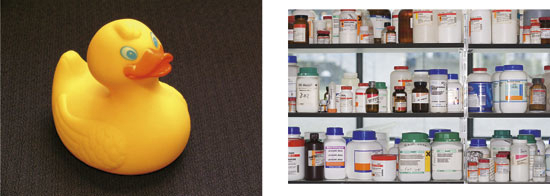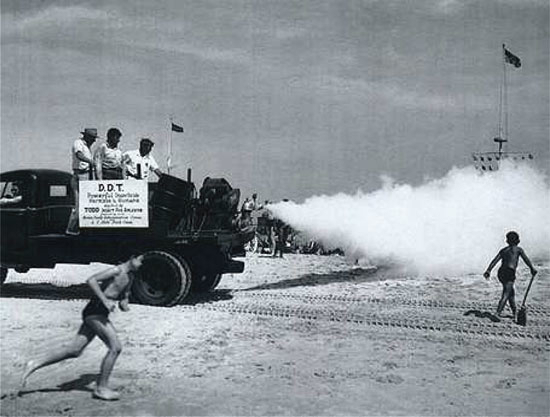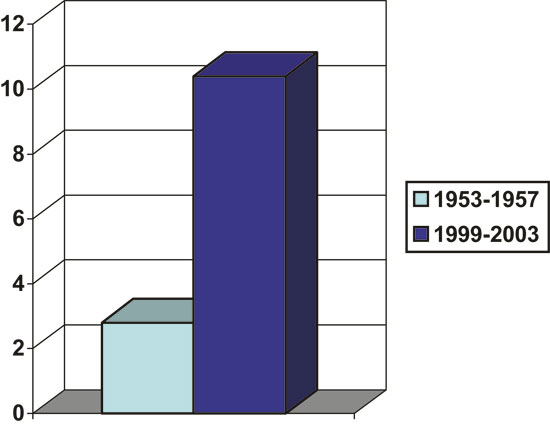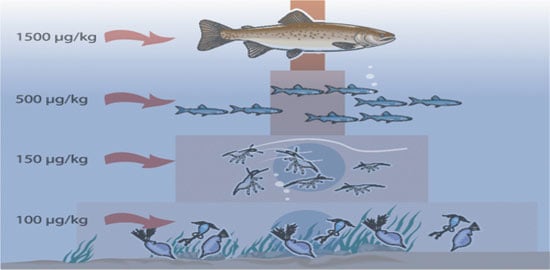2 Problems associated with hazardous substances
2.1 About chemicals
Everything is made of chemicals
Chemical substances are the building blocks of our world, and are constituents of everything we surround ourselves with. Chemicals include elements and chemical compounds, which contain atoms of different elements joined by chemical bonds. Ordinary table salt, for example, is a chemical compound of the elements sodium and chlorine. Chemical substances can also be mixed together without reacting chemically with each other, and such mixtures are called preparations. The term chemicals includes elements, chemical compounds and preparations, regardless of whether they occur naturally or are deliberately manufactured or formed as unintentional by-products. Thus, chemicals include substances that are useful and others that are not, hazardous and harmless substances, and natural and man-made substances.
This white paper does not deal with radioactive substances.

Figure 2.1 Chemicals are found both in finished products and in solid and liquid substances and preparations
Photo: Norwegian Pollution Control Authority and Scanpix
Most chemicals are useful
Chemicals and trade in chemicals make an essential contribution to our welfare and to better products and services for society as whole. Thus, chemicals provide many public goods, and we should be able to reap the benefits of their use. The use of dangerous substances too is often needed for wealth creation. The risks associated with using a particular chemical must therefore be weighed against the benefits derived from it, and against the risks associated with alternative substances. Even though most chemicals are useful, the use of certain substances can involve unacceptable risks for health and the environment.
Some substances are hazardous to health and the environment
Chemicals that may be dangerous to health and the environment are called hazardous substances. Their properties vary: they may be acutely toxic, corrosive, irritating to skin, sensitising or explosive. Carcinogenic, reprotoxic and mutagenic substances are considered to be most hazardous to health. Some hazardous substances are persistent (not easily broken down in the environment) and bioaccumulative (accumulate in food chains and in the human body). They are the substances that are most dangerous for the environment, and may also be very hazardous to health. They are categorised as ecological toxins (see 2.3).
People and the environment are exposed to hazardous substances through releases from production processes, in the working environment, during the use of products and from waste. This may entail risks to the health of the general population, the labour force, animals and other living organisms.
Injury to health and environmental damage can also be caused by accidents involving chemicals (industrial spills, accidents during transport of dangerous chemicals by road, rail or sea, fires, and accidents in the workplace and at home) and by abuse of chemicals (inhalants, intoxicants).
Textbox 2.1 From Silent Spring to ecological toxins

Figure 2.2 A cloud of DDT being sprayed over a beach in New York in 1945
Photo: UPI/Bettmann, National Geographic
It is more than 40 years since ecological toxins first made the headlines. In 1962, Rachel Carson published Silent Spring, which focused on the effects of the pesticide dichlorodiphenyltrichloroethane, or DDT. At the time, its use was considered to be acceptable in Norway as well. Rachel Carlson produced evidence of how DDT became concentrated along food chains and gave rise to serious problems, for example by disrupting reproduction in birds. Until then, DDT had been seen as highly effective in the fight against insect pests. Other substances whose use increased after the Second World War were polychlorinated biphenyls (PCBs) and mercury compounds. The scientific evidence presented in the 1960s and 1970s led to the establishment of international agreements to prevent releases of such substances. One of the earliest was the 1972 Oslo Convention, which addressed dumping of waste in the North-East Atlantic. A later example is the 2001 Stockholm Convention on Persistent Organic Pollutants, which is a global agreement.
During the 1980s, comprehensive systems were introduced to control industrial emissions, and releases of substances such as PCBs and dioxins have subsequently been dramatically reduced. Certain substances, such as PCBs, have been totally banned. Lead in petrol has been phased out.
Thus, long-term efforts make it possible to protect our health and the environment against ecological toxins. But it has often taken many years to stop the use of such substances.
The scope of work on chemicals has traditionally been wider in the context of the working environment than in the context of the environment, since people may be exposed to such a wide range of chemicals in different working environments. In addition to those categorised as ecological toxins, they often include reactive compounds that readily break down in the environment and thus do not constitute an environmental threat or a health risk for the population as a whole, although they may pose a health risk for workers.
Textbox 2.2 Hazard and risk
Chemicals differ from each other in their intrinsic properties, for example their water and fat solubility, and the ways in which they are hazardous to health and the environment. For example, a substance may trigger allergy, be carcinogenic, or be toxic to aquatic animals and plants. Thus, the hazards a substance represents are related to its intrinsic properties. If people or animals are exposed to hazardous substances, they may be exposed to a risk, depending on the degree of exposure. Thus, whether a substance poses a risk depends not only on its hazardous properties but also on how much is released and the degree of exposure.
The risk of environmental damage or injury to health caused by chemicals is related to the level of exposure, see box 2.2. It is usually neither possible nor desirable to avoid the use of hazardous substances entirely, but it is important to keep the level of exposure low enough to be safe. This of course requires sufficient knowledge to determine safe levels of exposure. The fact that a substance is found in the environment or in people does not in itself mean that it constitutes a risk to health or the environment. The fact that many substances are being more and more widely detected in people and animals, on the other hand, is an indication that they are spreading to the environment and being taken up by living organisms, although the increasing sensitivity of analytical techniques may also be a partial explanation.
2.2 Hazardous substances can cause irreversible damage
Hazardous substances can cause various forms of irreversible long-term damage. Since 1999, the Norwegian Medical Birth Registry has registered the number of new-born boys with undescended testicles. The number is rising, and one hypothesis is that endocrine disruptors may be one of several causes of this birth defect.

Figure 2.3 Testicular cancer in Norway (annual average of age-adjusted incidence rates per 100 000 persons)
Source Norwegian Pollution Control Authority
The incidence of certain types of cancer that are hormone-dependent (testicular cancer and breast cancer) is rising. Some of the cancer types whose incidence has risen most from 1953–57 to 1999–2003 are testicular cancer (270 %), see figure 2.3, prostate cancer (219 %) and breast cancer (102 %). Norway is now the country with the highest prevalence of testicular cancer. Exposure to hazardous substances, including endocrine disruptors, is one of many suspected causal factors behind the increase in the incidence of cancer. For example, fetal exposure may be involved in the development of testicular cancer.
Textbox 2.3 Endocrine disruptors
Endocrine disruptors are chemicals that can disturb hormonal regulation in humans and animals and have adverse effects on health. These may include fetal damage, a decline in reproductive capacity, immune dysfunction or a rise in the number of cases of certain forms of cancer. Examples of industrial chemicals that may act as endocrine disruptors are PCBs, DDT, tributyl tin compounds (TBT), nonyl- and octylphenol and bisphenol A.
In the 1960s, there was a decline in the reproductive rate of seals in the Baltic Sea and North Sea, which is believed to have been related to contamination with PCBs. Studies showed a high rate of miscarriages, uterine damage and many sterile females. More recently, the levels of PCB contamination have been reduced, and the seal populations have been recovering.
There are no clearly established links between disruption of the hormonal system and exposure to chemicals in humans, but it has been suggested that for example reduced sperm quality, reproductive disorders and the increasing frequency of testicular cancer can be related to exposure to chemicals.
Allergies are a growing health problem: anyone who becomes allergic to nickel, for example, remains allergic for the rest of their life.
Reduced fertility has been documented in seals, birds and polar bears as a result of exposure to PCBs, and disruption of the development of reproductive organs and reproductive dysfunction in the dogwhelk has been shown to be a result of leaching of organotin substances from anti-fouling systems used on boats.
2.3 Ecological toxins are the greatest long-term threat
The greatest global threats from chemicals are posed by ecological toxins. Norway categorises hazardous chemicals as ecological toxins if they are persistent (do not break down easily) and bioaccumulative (build up in food chains and the environment). Once such substances enter a food chain, they can be transferred from one stage to the next. Thus, their use and release gradually contaminate soil, air, water, people and animals.
Ecological toxins include organic pollutants such as PCBs, certain metals such as mercury, chromium and lead, and also substances with endocrine disrupting properties.
Textbox 2.4 Children and adolescents at greatest risk
An EU project called the Policy Interpretation Network on Children’s Health and Environment (PINCHE) has demonstrated that children are often particularly susceptible to environmental factors, including ecological toxins. Neurotoxicants (substances that are toxic to the nervous system) are among the greatest threats to Norwegian children.
All children born today have several hundred anthropogenic substances in their blood. These pass from mother to child during pregnancy, and children are further exposed to ecological toxins through breast milk. The presence of these substances does not represent an immediate risk, and breast milk is healthy in other ways. Nevertheless, ecological toxins can reduce children’s opportunities for leading full and active lives. For example, a clear link has been shown between exposure of children to high levels of mercury and lead and their intellectual capacity and ability to learn. However, the levels measured in Norwegian children are below those that have been shown to have negative effects, and levels of known ecological toxins in breast milk have decreased in recent years. On the other hand, substances that have recently been recognised as ecological toxins have been detected, for example brominated flame retardants and PFOS.
Ecological toxins bioaccumulate in food chains. Thus, even small releases can over time result in such high concentrations that they represent an unmanageable risk and have adverse effects on people and animals. This makes it difficult to determine the levels of releases of ecological toxins that represent an acceptable risk. Nonetheless, it is possible to determine safe levels of human exposure for most known ecological toxins. Thus, it should be possible to prevent adverse effects caused by the intake of these substances by thorough control programmes for food.

Figure 2.4 Children are exposed to ecological toxins via breast milk
Photo: Marianne Otterdahl-Jensen
Textbox 2.5 Pollution in the Arctic
Two thorough assessments by the Arctic Monitoring and Assessment Programme (AMAP) have documented high levels of persistent organic pollutants (POPs) and heavy metals in Arctic, which originate from industrial areas further south. AMAP’s reports show a number of impacts on humans and animals.
Once ecological toxins have entered the environment, it takes many years to reduce pollution levels again. Even though it is 30 years since the PCBs were prohibited, pollution levels in Norway and the Arctic are still substantial, and are only dropping slowly. The presence of PCBs is also one of the reasons why the food safety authorities have advised people to limit their intake of fish and shellfish caught in 31 harbours and fjords in Norway.
In addition, people throughout the country are advised to limit their intake of large specimens of freshwater fish such as pike, trout and perch, because they are contaminated with mercury as a result of long-range transport to Norway and earlier releases of mercury in Norway.

Figure 2.5 Accumulation of organic mercury compounds in the food chain
Source Norwegian Pollution Control Authority and Norwegian Institute for Water Research
2.4 Pollution does not stop at national borders
Ecological toxins can be transported over long distances from the source of pollution by air and ocean currents. Many developing countries and the growing economies in Asia use large quantities of ecological toxins. In developing countries, the use of hazardous substances is still causing serious local damage, and failure to control pollution is hindering growth and development and also having a global impact. Concentrations of ecological toxins are generally highest near sites where they are released, but even areas far away from the most important sources can be affected. Norway and the Arctic receive considerable inputs of long-range transboundary pollution, in addition to pollution from the Arctic countries themselves. The Arctic is particularly vulnerable to long-range transport of ecological toxins because of the dominant air and ocean currents.
Textbox 2.6 Mercury reaches the Arctic from Asia
Mercury releases from coal-fired power plants in Asia are the largest source of mercury deposition in the Arctic.
The main sources of releases of hazardous substances used to be industrial production processes. Today, releases from products are more important.
The world’s chemical industry is growing, and it is one of the largest sectors in the global economy. Hazardous substances are also spread more widely through international trade in products. Most products used in Norway are imported from other countries. In many cases, importers and distributors know too little about the chemical content and possible adverse effects of their products. This applies for example to textiles containing brominated flame retardants and perfluorinated substances, and electronic products containing heavy metals and brominated flame retardants.
2.5 Serious gaps in our knowledge of chemicals
We still lack basic knowledge of the health and environmental hazards associated with most substances. This makes it impossible to evaluate how great a risk they pose to health and the environment. We know even less about what impacts they are having on the natural environment, particularly about the long-term impacts of contamination of food chains by ecological toxins. In many cases, we also lack information on how substances are converted into degradation products in the environment.
Textbox 2.7 Recently recognised ecological toxins
There can be a long delay between the first use of a substance and the realisation that it is dangerous to health and the environment. Perfluorooctyl sulphonate (PFOS) and perfluorooctanoic acid (PFOA) were used for a long time before it was understood that they are ecological toxins. PFOS is reprotoxic and shows no signs of biodegradation in the environment. In recent years, environmental monitoring has revealed that these substances are now present in food chains, and they have also been found in the Arctic, for example in polar bears.